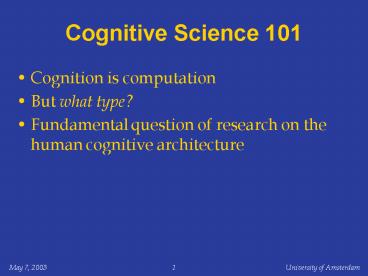Cognitive Science 101 - PowerPoint PPT Presentation
1 / 26
Title:
Cognitive Science 101
Description:
University of Amsterdam. 1. Cognitive Science 101. Cognition is ... Amsterdam ... University of Amsterdam. 11. Two Fundamental Questions. 2. What are ... – PowerPoint PPT presentation
Number of Views:63
Avg rating:3.0/5.0
Title: Cognitive Science 101
1
Cognitive Science 101
- Cognition is computation
- But what type?
- Fundamental question of research on the human
cognitive architecture
2
Cognitive Architecture
- Rules operating on symbols
- grammar
- logic
- Spreading activation in simple processors
- massively interconnected in a large network
- Symbolic vs. Connectionist architecture?
- Integrated Connectionist/Symbolic (ICS)
Architecture - Grammar Phonology
- Architecture defined by four components
3
The ICS Architecture
dogs
d?gz
A
4
Processing I Activation
- Computational neuroscience
- Key sources
- Hopfield 1982, 1984
- Cohen and Grossberg 1983
- Hinton and Sejnowski 1983, 1986
- Smolensky 1983, 1986
- Geman and Geman 1984
- Golden 1986, 1988
5
Processing I Activation
Processing spreading activation is
optimization Harmony maximization
6
The ICS Architecture
cat
kæt
A
7
Processing II Optimization
- Cognitive psychology
- Key sources
- Hinton Anderson 1981
- Rumelhart, McClelland, the PDP Group 1986
Processing spreading activation is
optimization Harmony maximization
8
Processing II Optimization
Processing spreading activation is
optimization Harmony maximization
9
Processing II Optimization
- The search for an optimal state can employ
randomness - Equations for units activation values have
random terms - pr(a) ? eH(a)/T
- T (temperature) randomness ? 0 during search
- Boltzmann Machine (Hinton and Sejnowski 1983,
1986) Harmony Theory (Smolensky 1983, 1986)
10
The ICS Architecture
cat
kæt
A
11
Two Fundamental Questions
? Harmony maximization is satisfaction of
parallel, violable constraints
- 2. What are the constraints?
- Knowledge representation
- Prior question
- 1. What are the activation patterns data
structures mental representations evaluated
by these constraints?
12
Representation
- Symbolic theory
- Complex symbol structures
- Generative linguistics (Chomsky Halle 68 )
- Particular linguistic representations
- Markedness Theory (Jakobson, Trubetzkoy, 30s )
- Good (well-formed) linguistic representations
- Connectionism (PDP)
- Distributed activation patterns
- ICS
- realization of (higher-level) complex symbolic
structures in distributed patterns of activation
over (lower-level) units (tensor product
representations etc.) - will employ local representations as well
13
Representation
14
The ICS Architecture
cat
kæt
A
15
Constraints
NOCODA A syllable has no coda Maori
H(as k æ t) sNOCODA 16
The ICS Architecture
cat
kæt
A
17
The ICS Architecture
cat
kæt
A
18
Constraint Interaction I
- Harmonic Grammar
- Legendre, Miyata, Smolensky 1990 et seq.
19
Constraint Interaction I
The grammar generates the representation that
maximizes H this best-satisfies the constraints,
given their differential strengths
Any formal language can be so generated.
20
The ICS Architecture
cat
kæt
A
21
The ICS Architecture
cat
kæt
A
?
22
The ICS Architecture
cat
kæt
A
HG Powerful French syntax (Legendre, et al. 1990
et seq.)
Prince Smolensky (1991 et seq.)
Too powerful?
23
The ICS Architecture
cat
kæt
A
24
The ICS Architecture
cat
kæt
A
25
Constraint Interaction II OT
- Strict domination
- Grammars cant count
- Stress is on the initial heavy syllable iff the
number of light syllables n obeys
No way
26
Intro to OT
27
The ICS Architecture
cat
kæt
A































